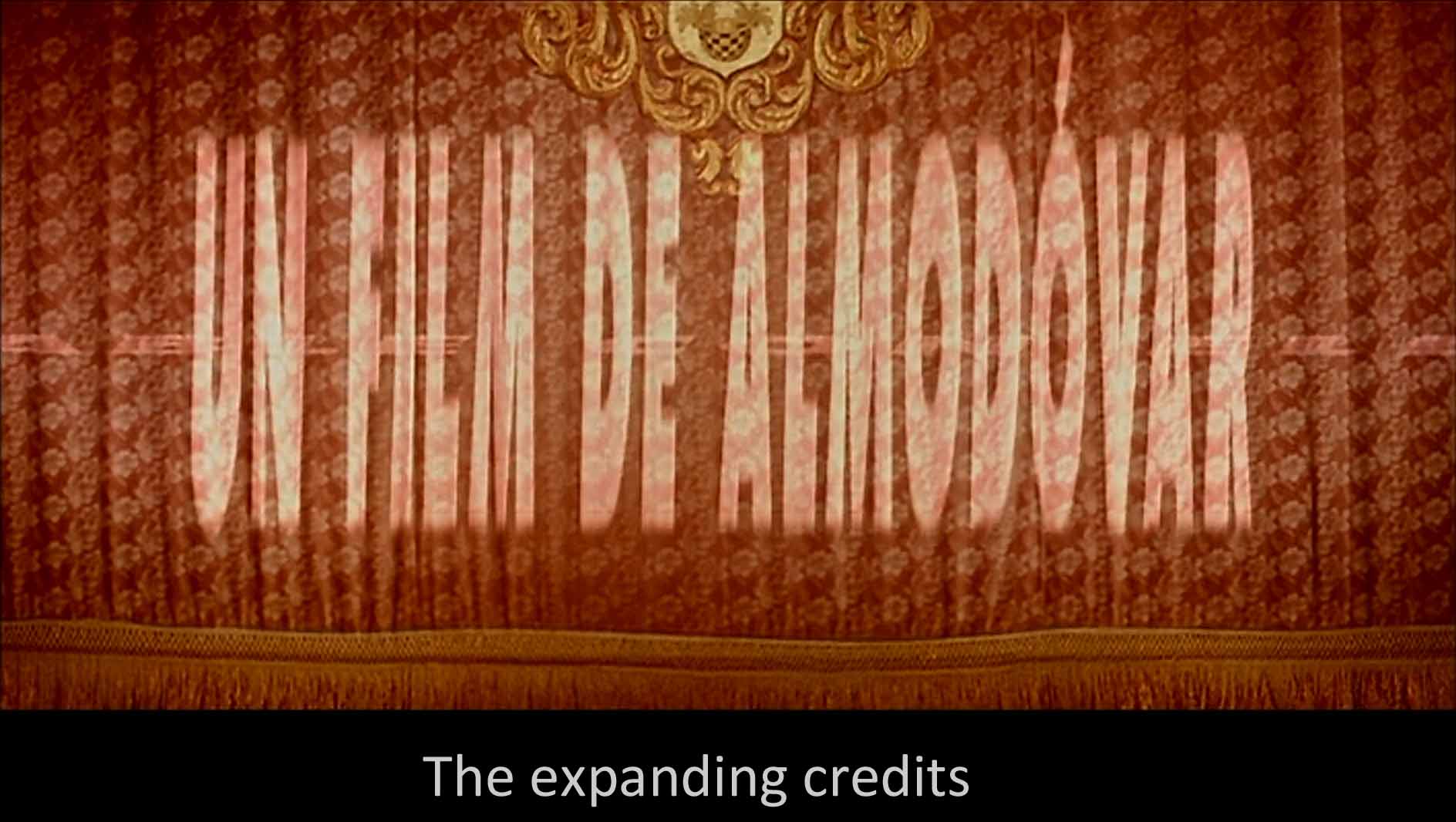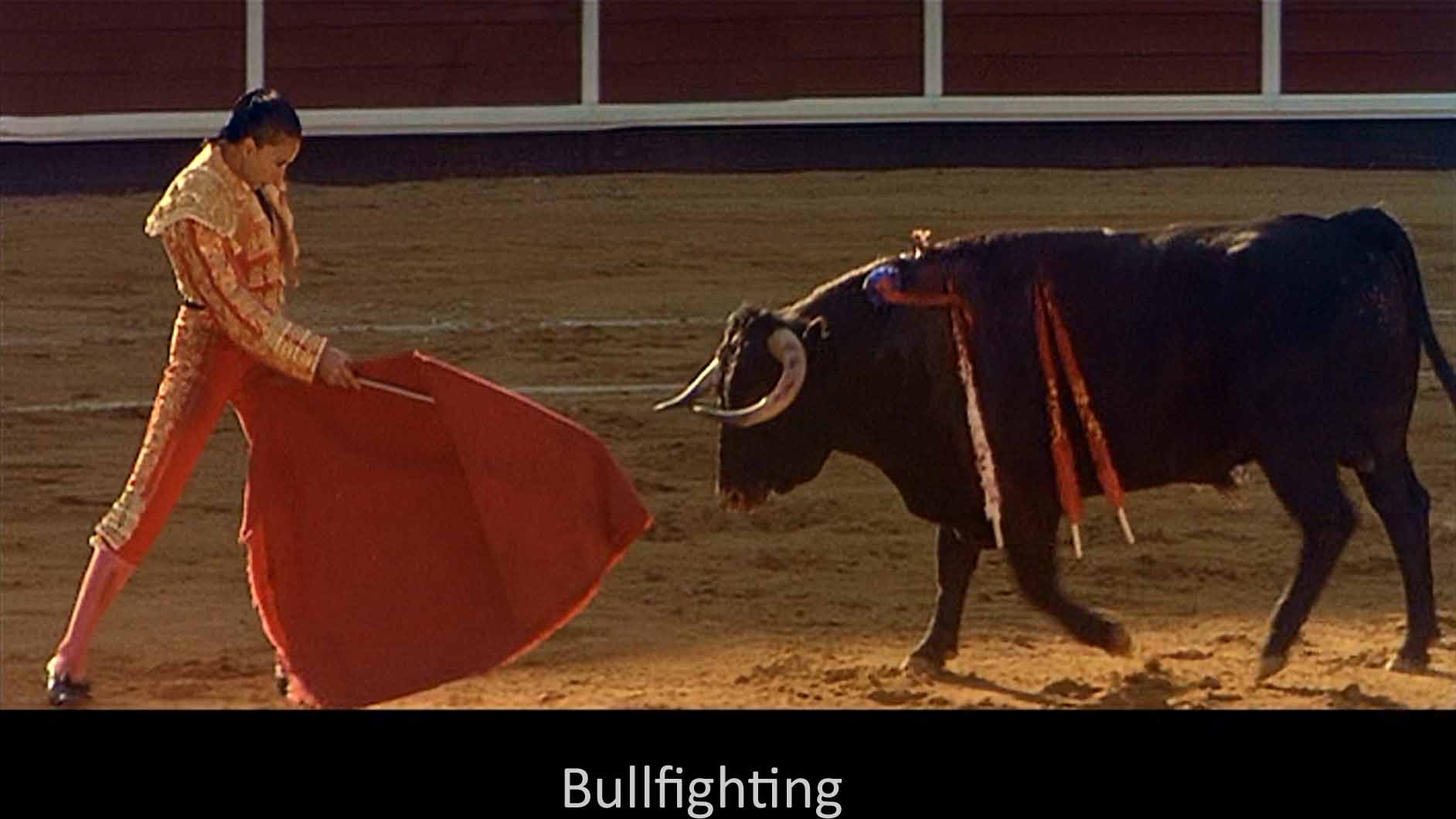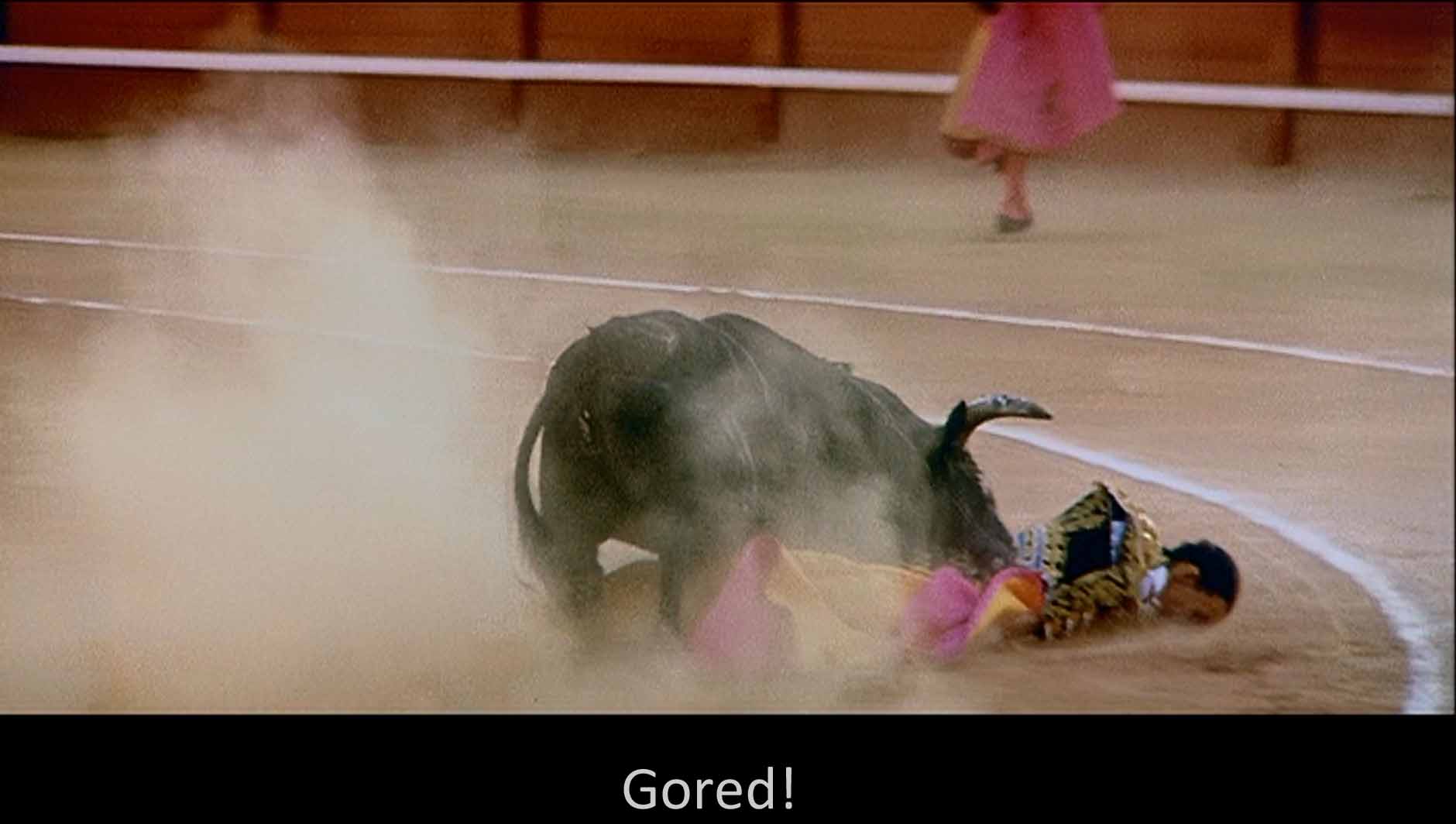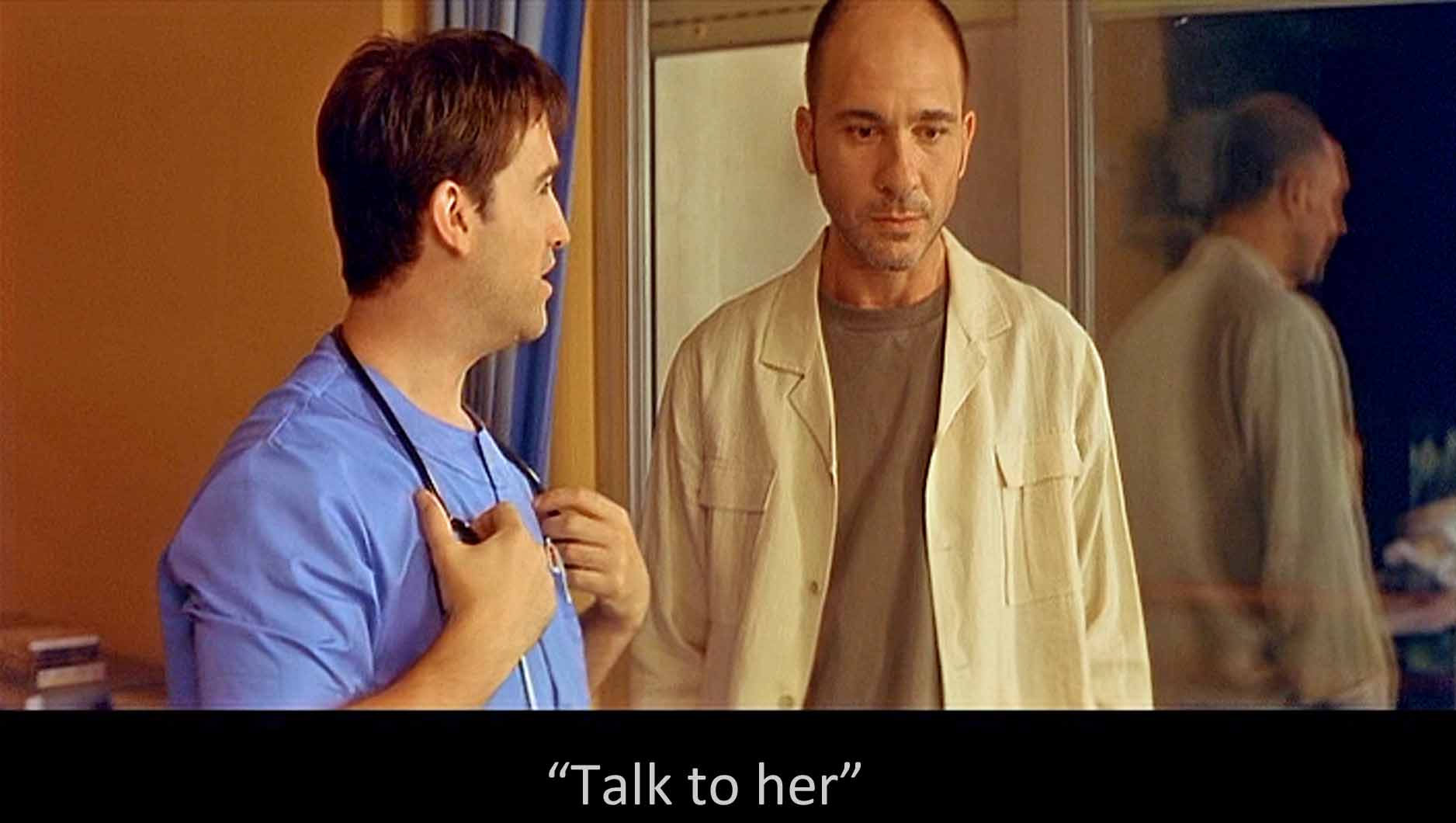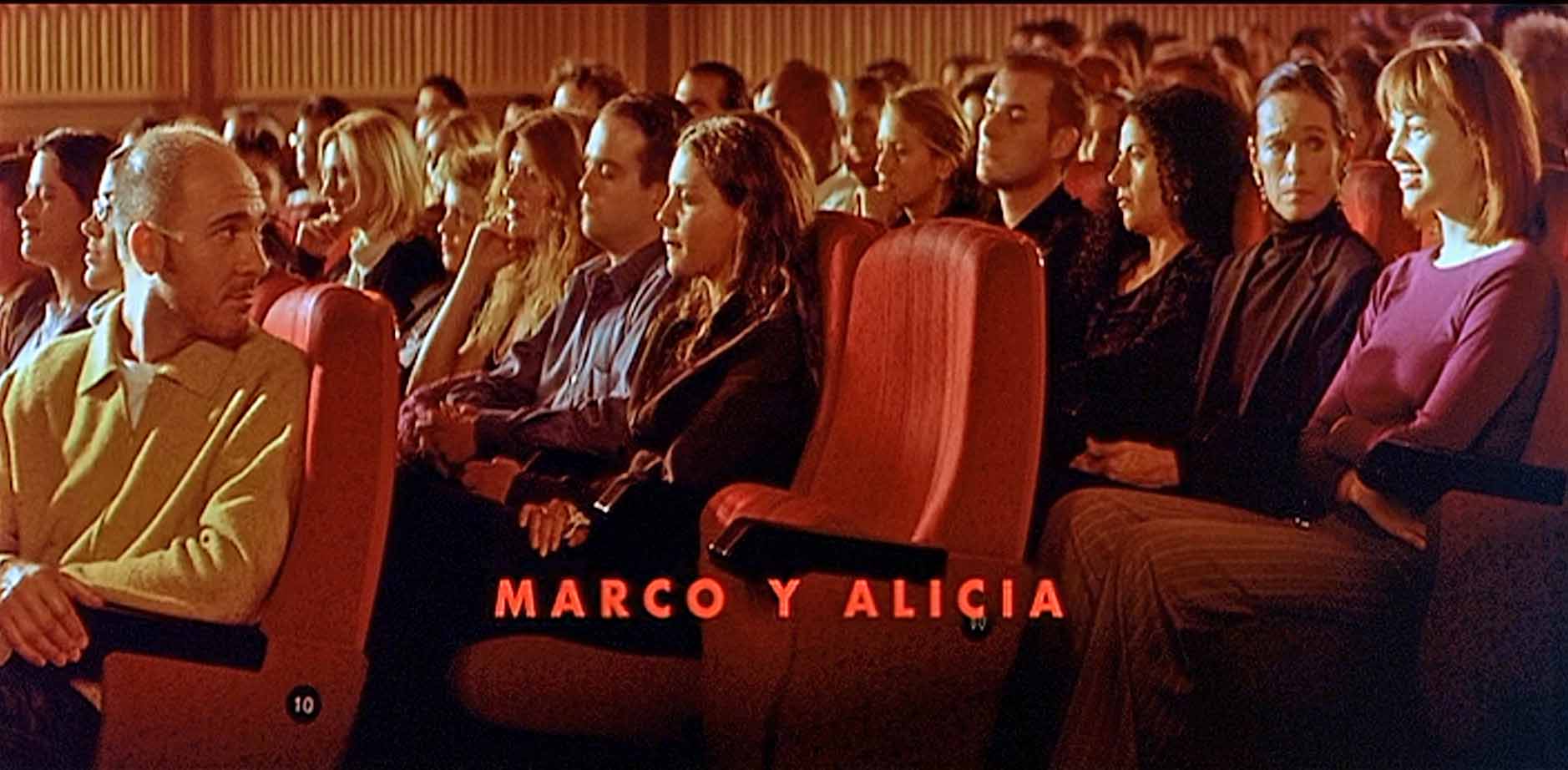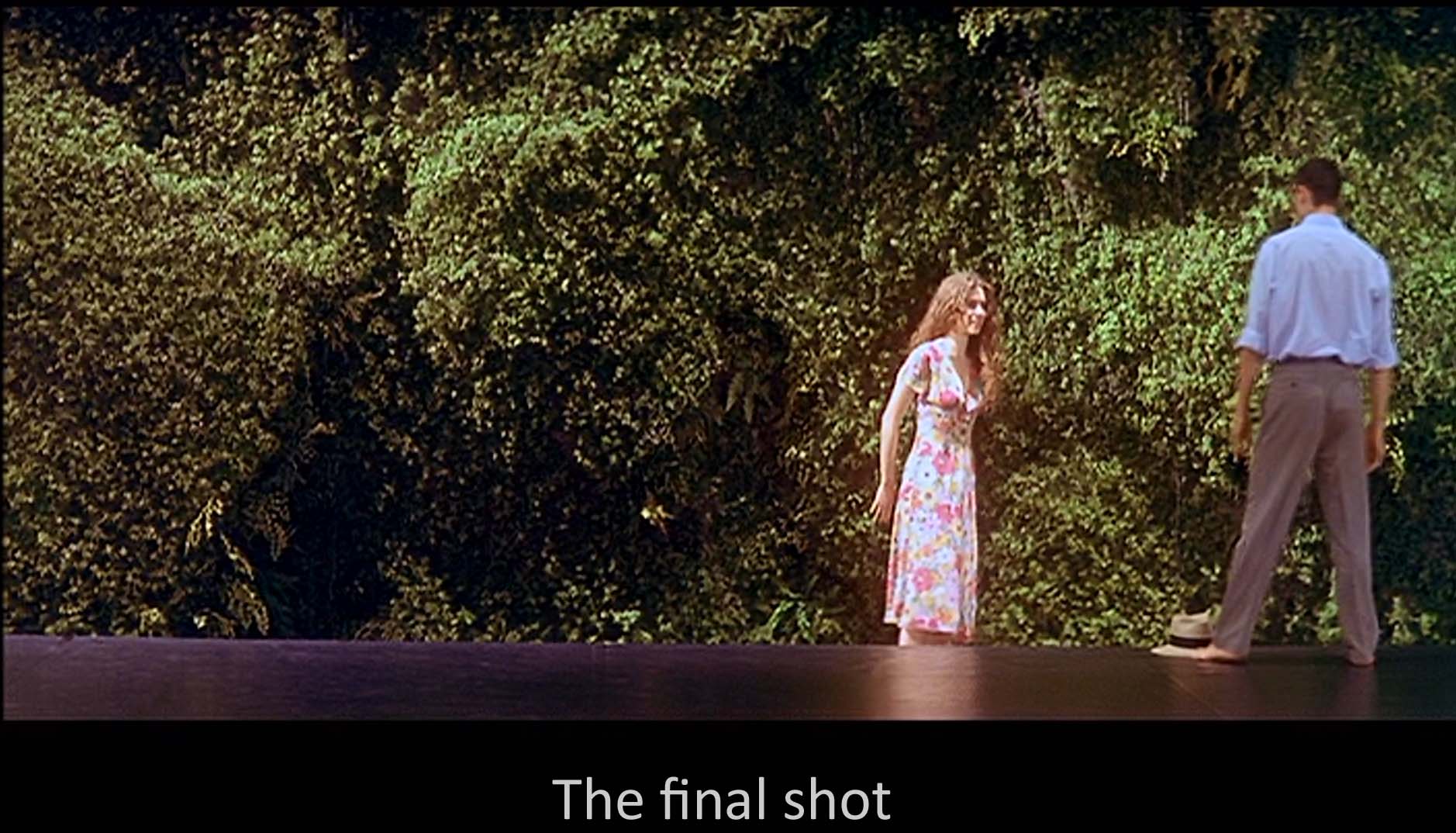Intimacy, entering the mind—or the body—of another human being? That’s what art is all about, isn’t it? And love? Anyway, that, I think, is what this densely imagined film is about, entering the mind or body of another through love or art.
The film has four works of art embedded in it. There are two dances by Pina Bausch that occupy key positions, the opening and closing shots of the film. There is the long song, “Cucurrucucú Paloma,” not so much sung as confided by the tenor Caetano Veloso. And there is a silent movie The Shrinking Lover, created by Almodóvar himself. We, and the characters are spectators of them. They have little to do directly with the plot, just as art is separate from life. However, Spaniards regard bullfighting as more an art than a sport, and bullfighting has a lot to do with this plot.
In the plot, two men have fallen in love with two women: Benigno (Javier Cámara) with Alicia (Leonor Watling), a student dancer; Marco (Darío Grandinetti) with Lydia (Rosario Flores), a bullfighter. As always with Almodóvar, the characters define themselves by performing: dancer; bullfighter; one man is a journalist, the other a nurse with an audience of the other nurses and the comatose woman he is nursing. The dancer Alicia jaywalks, is struck, and ends up in a coma in the hospital where for four years Benigno is her devoted nurse. Then Lydia is gored by a bull, and she ends up in a coma in the same hospital as Alicia. But her lover Marco cannot bear to touch her. The two men meet in the hospital, and Benigno instructs Marco in how to relate to a beloved woman who happens to be in a coma: you live her life for her, seeing the art she would have seen and telling her about it. “Talk to her,” says Benigno. He does, but he also massages the nude Alicia in the most intimate way.
The works of art don’t forward the plot directly, although Marco and Benigno meet at the Pina Bausch concert. And that first dance in which the dancer runs into walls—obstacles—foreshadows the bull running into Lydia and the car running into Alicia. Like the male dancer, neither lover can protect these women. The silent movie reveals Benigno’s felony, and the song tells of an unhappy woman leaving her lover as Lydia had planned to leave Marco. The final dance shows couples loving and touching, foreshadowing the upcoming romance of Marco and Alicia.
They have met coincidentally, at a Pina Bausch dance concert, as, at the beginning of the film, Benigno and Marco meet. Marco happens to see Lydia interviewed on television and plans to meet her. She happens to go to the same wedding Marco attends (of his former lover). Marco cements his relationship with Lydia because there happens to be a snake in her house. As Despina Kakoudaki points out, Almodóvar’s use of coincidence this way suggests a socially thick world in which there are no strangers. People are connected without knowing it. They touch, often through works of art.
As in the final dance, this is a movie that contrasts different kinds of touch. Bullfighting involves touch—the body; so does dance. The touch of the dancers in Pina Bausch’s ballets is controlled, artistic touching, as is the bullfighting—at first. There is the sexual touching by Benigno and the hero of the silent movie. Not for Benigno are the latex gloves the other nurses wear. Finally, the bull gores Lydia, a car strikes Alicia—these are forcible touches, the wrong, bad kind, the kind that will put Benigno in jail.
Touch contrasts with talk—words. The Spanish title is “talk with her,” not to her as in the translation, talk with her, although she cannot talk back. This is talk for the sake of the talker, not the listener.
Touch enters into the recurring talk and shots of beds: in the television interview, in Lydia’s hotel room or Benigno’s catalog, in the silent movie, in Marco’s telling of his former love, and, of course, the hospital beds. We see a lava lamp in Alicia’s room with its blobs meeting and parting. Later, Benigno will talk of the rain and watch the raindrops meet and merge on the window.
The artworks also play off touch and talk. The first dance is all touch, no talk or song. The song is all talk, no touch, talk about a woman who has departed. The silent movie is all touch, no talk. And the final dances harmoniously combine touch and song (or talk) between men and women. They signal the love of Marco and Alicia, the journalist (words) and the dancer (body, touch) that will happen after the movie is over.
The film tells us by one of its intertitles that that romance will happen: “Marco y Alicia.” These intertitles act as signposts to take us through the odd sequence of flashbacks by which Almodóvar tells this story. Slowly, we realize it spans—what? five years? The intertitles, like the final credits, start out in two pieces that come together; they start small, then magnify until they disappear. (An alphabetic version of these love affairs.) Then there are the odd little shots that are the opposite, minifying rather than magnifying. Almodóvar shows us miniature cars in Alicia’s bedroom (the opposite of the car that will put her into a coma). A bartender asks Lydia if she wants a tall glass or a small one. The receptionist at Benigno’s prison amplifies her voice so that the visiting Marco can hear. The psychiatrist’s receptionist “takes an elephant-sized dump.” At the wedding of Marco’s former lover, the priest speaks of God’s having “caused this love to grow in you.” And then there is the silent movie, The Shrinking Lover. Echoing The Incredible Shrinking Man (Jack Arnold, 1957), Almodóvar’s little movie minifies and minifies its lover until he can perform the ultimate act of entering his beloved’s mind and body. Silently.
Magnifying and minifying: things seem larger as we get nearer and smaller as we get farther away. Almodóvar does a lot in this film with people getting close, parting, and getting close again. The song “Cucurrucucú Paloma” tells of a lover mourning a woman who has parted from him. I take it, that is why it occupies so central and magical a position in the film. The first scene has Benigno and Marco sitting side by side, but not knowing each other. Much later Benigno invites Marco to enter Alicia’s room; the two men come together and become close friends. Eventually, Marco moves into Benigno’s vacated apartment. They touch through the glass when Benigno is jailed. Lydia physically leaves the television show when the prying interviewer insists on talking about his “sharing her bed” with “the Valencia Kid.”
Benigno inches his way closer to Alicia, first seeing her at a distance through his apartment window, then meeting her on the street, then invading her family’s apartment (and stealing her hair clip as a fetish), then massaging her in the hospital and trying to enter her mind; finally he enters her body. The silent movie lover does much the same. Marco meets Lydia in a bar, and they slowly become lovers. He watches from a distance as Angela, his former lover, gets married, and he tells Lydia the long story of how he tried to keep Angela away from drugs and how her parents kept her away from him. He does not know that Lydia, too, has left him. After Lydia’s death, Marco flees to foreign parts (he had previously written travel guides). Finally, in jail, Benigno is cut off from all contact. He dies trying to unite himself with Alicia in some coma-world. Marco, however, sits in a theater with Alicia two rows behind him: some kind of beginning-to-touch.
Then there is the curious episode of the snake. Marco has just dropped Lydia off at her house and is driving away when he hears a scream and rushes back. There is a snake in the house, and Lydia has a violent snake phobia. Marco goes back in the house, clobbers the snake with a handy baseball bat, and reassures Lydia. But she never wants to touch anything in that house again.
To me the snake sounds a Biblical note. (In an interview, Almodóvar denied intending this, “but I like that interpretation” [223].) God, cursing Adam and Eve, also curses that talkative snake: “I will put enmity between you [the snake] and the woman.” And Lydia banishes herself. She repeatedly touches holy medals before a bullfight. Her sister has moved a little home-made shrine to the hospital and is repeatedly told, “You must have faith. You must believe in miracles.” But, of course, in the resolutely secular world of Almodóvar, Lydia dies and nuns are raped.
Almodóvar is also telling a folkloric story. The hospital where Alicia sleeps is called “El Bosque,” the forest, and she is a kind of Sleeping Beauty (as first pointed out by Adriana Novoa). She is brought back to life with, well, not a kiss, but a rape. You could also think of Pygmalion. Benigno treats Alicia as kind of sculpture, even a Barbie doll, that he can play with, dressing and undressing her, polishing her nails, washing her hair, even providing a towel for her periods.
Almodóvar has a huge, rich imagination and nowhere is that more in evidence than in Talk to Her. He writes all his own scripts, and he got the Oscar for Best Original Screenplay for this one. He was also nominated for Best Director. Two men in love with women in comas and perhaps in love with each other—what an extraordinary idea. Outrageous, really. Yet this is also a personal film, close to Almodóvar himself. Pina Bausch, Veloso—these are friends of his. The singing of the song “Cucurrucucú Paloma” takes place at his own home with an audience of other friends and some of his actors, but the episode also plays its part in this improbable plot. He is playing with art and life as only great artists can do. Art reflects and influences life, while we who live try to perform as artists—and probably fail. Through art we enter the mind of the artist and the minds of those with whom we are sharing the art.
Items I’ve referred to:
Almodóvar, Pedro. Almodóvar on Almodóvar. Ed. Frederic Strauss. Trans. Yves Baignères and Sam Richard. London: Faber and Faber, 2006
Kakoudaki, Despina. “World Without Strangers: The Poetics of Coincidence in Pedro Almodóvar’s Talk to Her. Camera Obscura 23. 2 (2008): 1-39.
Novoa, Adriana. “Whose Talk is It? Almodóvar and the Fairy Tale in Talk to Her.” Marvels and Tales 19.2 (2005): 224-48.
